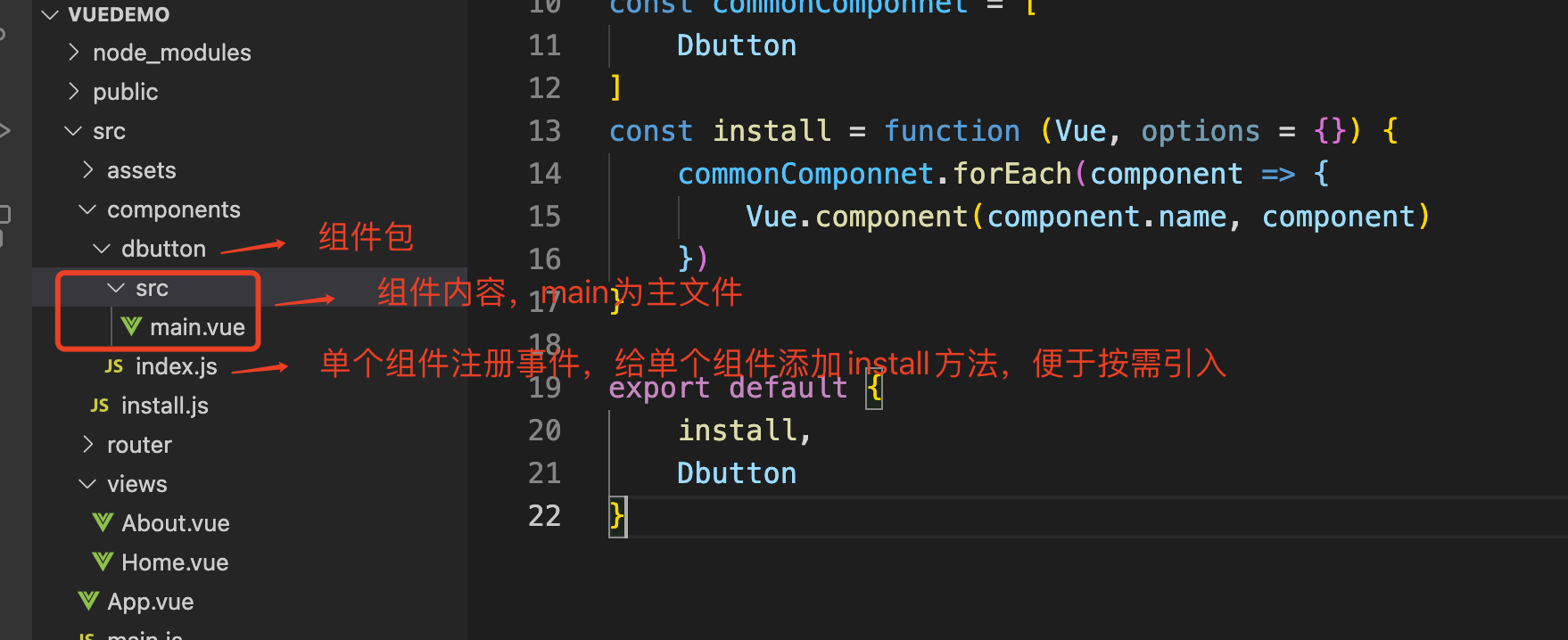1、首先我们要先了解下Vue.use(plugin)的用法。
-
参数:
{Object | Function} plugin
-
用法:
安装 Vue.js 插件。如果插件是一个对象,必须提供
install方法。如果插件是一个函数,它会被作为 install 方法。install 方法调用时,会将 Vue 作为参数传入。该方法需要在调用
new Vue()之前被调用。当 install 方法被同一个插件多次调用,插件将只会被安装一次。
下面是vue2.0源码,使用vue.use(plugins)其实是将plugin放到vue构造器的_installedPlugins属性里,防止重复安装,并且以Vue.component的方式做全局组件。
Vue.use = function (plugin) {
// 获取vue构造器当前已经use的组件,如果组件已经存在则返回当前vue对象,避免同一组件重复use
var installedPlugins = (this._installedPlugins || (this._installedPlugins = []));
if (installedPlugins.indexOf(plugin) > -1) {
return this
}
// additional parameters
// 将类数组对象转化成数组,满足apply(对象, 数组)
var args = toArray(arguments, 1);
args.unshift(this);
if (typeof plugin.install === 'function') {
plugin.install.apply(plugin, args);
} else if (typeof plugin === 'function') {
plugin.apply(null, args);
}
// 填充到vue的_installedPlugins中
installedPlugins.push(plugin);
return this
};
plugin必须是个对象或者方法,对象的话必须存在install(), 方法的话默认该方法就是install();
2、如何封装自己的组件
这里分自写组件库使用和自己项目上使用。
-
自写组件库使用
-
参考element-ui,具体分层和代码如下
1) 按照包格式编写组件。
内容:

2)各文件内容/dbutton/src/main.vue
<template> <button class="btn">点击</button> </template> <script> export default { name: "Dbutton", // 这里名称建议为组件包名称,首字母大写 components: {}, data() { return {}; }, computed: {}, watch: {}, created() {}, mounted() {}, methods: {}, }; </script> <style lang='scss' scoped> //@import url(); 引入公共css类 .btn { padding: 12px 20px; font-size: 16px; background: blue; border-radius: 5px; color: #ffffff; &:hover { background: red; } } </style>/dbutton/src/index.js
import Dbutton from './src/main'; // 给单独的组件添加install事件,便于按需注册 Dbutton.install = Vue =>{ Vue.component(Dbutton.name, Dbutton); } export default Dbutton;/dbutton/src/install.js
import Dbutton from './dbutton/index.js'; // 这里为组件数组,便于install方法循环 const commonComponnet = [ Dbutton ] // 注册全局install方法,这里的install会循环遍历component,给vue实例注册全局组件 const install = function (Vue, options = {}) { commonComponnet.forEach(component => { Vue.component(component.name, component) }) } // 导出对象,对象属性为各组件,以及install方法 export default { install, Dbutton }3) main.js使用
全局引入。这里使用use不仅会调用全局的install(),也会调用各组件的install(),但是没有影响。vue.use()已经给我们做了处理,相同组件只允许注册一次。
import HavikerUI from './components/install'; Vue.use(HavikerUI);局部引入。这样的话就只会调用Dbutton的install().
import HavikerUI from './components/install'; const { install, Dbutton } = HavikerUI; Vue.use(Dbutton);
-
-
项目使用
项目上所使用的组件分为两种,全局组件和局部组件。局部组件在对应页面import后使用即可,全局组件去掉/dbutton/src/index.js,修改/dbutton/src/install.js的引入,改为import Dbutton from './src/main'; 即可。
-
如何开发插件
Vue.js 要求插件应该有一个公开方法 install。这个方法的第一个参数是 Vue 构造器,第二个参数是一个可选的选项对象。
在 install 方法里面,便可以做相关的处理:
添加全局方法或者属性
添加全局资源:指令/过滤器/过渡等,
通过全局 mixin 方法添加一些组件选项,
添加 Vue 实例方法,通过把它们添加到 Vue.prototype 上实现。
一个库,提供自己的 API,同时提供上面提到的一个或多个功能
MyPlugin.install = function (Vue, options) {
// 1. 添加全局方法或属性
Vue.myGlobalMethod = function () {
// 逻辑...
}
// 2. 添加全局资源
Vue.directive('my-directive', {
bind (el, binding, vnode, oldVnode) {
// 逻辑...
}
...
})
// 3. 注入组件
Vue.mixin({
created: function () {
// 逻辑...
}
...
})
// 4. 添加实例方法
Vue.prototype.$myMethod = function (methodOptions) {
// 逻辑...
}
}
